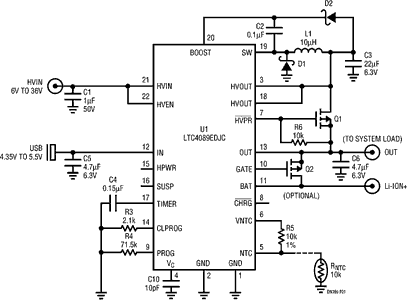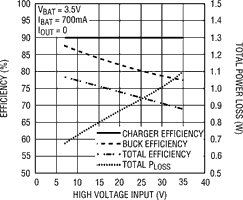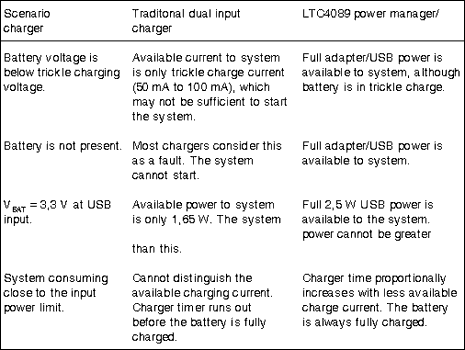Design Note: Dual-input Li-Ion battery charger accepts USB and 6-36 V input
18 October 2006
Power Electronics / Power Management
Liu Yang, Linear Technology
There are a number of advantages to offering USB and high input voltage power and battery-charging capability in handheld devices such as GPS navigators, PDAs, digital still cameras, photoviewers and MP3 players.
For instance, the charging and operation from USB offers the obvious convenience of not requiring a travel adapter. High voltage sources, such as Firewire and 12 V to 24 V adapters are even better, since they provide faster charging than USB and allow charging in more places, such as in the car. Nevertheless, there is an important design consideration with high voltage power sources: the voltage difference between the high voltage source and the battery in the handheld device is very large. Since a linear charger cannot handle the power dissipation, a switching charger is required.
The LTC4089 and LTC4089-5 (Figure 1) conveniently integrates a high voltage and wide input range (6 V to 36 V, with 40 V absolute maximum) monolithic 1,2 A buck switching regulator and a USB power manager/charger into a compact thermally enhanced 3 x 6 mm DFN package.
Figure 1. Schematic illustrates multiple input voltage capability
The LTC4089's buck regulator output voltage tracks the battery voltage to within 300 mV. Linear Technology's 'Bat-Track' feature minimises overall power dissipation. The LTC4089-5 has a fixed 5 V at OUT when power is applied at HVIN. When power is supplied from the USB port, the power manager maximises the available power to the system load; up to the full USB available power of 2,5 W. It automatically adjusts the Li-Ion battery charge current with respect to the system load current to maintain the total input current compliance within the USB limits.
The total solution size is less than 2 cm² with all components on one side of the PCB.
Adaptive buck minimises total power loss
The LTC4089's buck converter output voltage VOUT tracks the battery voltage VBAT. It is always 0,3 V higher than VBAT, so that the battery can be charged quickly while minimising overall power dissipation. Figure 2 shows the overall efficiency at various input voltages, where the total power dissipation is less than 1,1 W. Furthermore, if the battery is excessively discharged and VBAT falls too low, the minimum VOUT is 3,6 V to ensure continuous system operation.
Figure 2. Graph shows LTC4089 high voltage charger efficiency and total power loss
Power available to the system is maximised
In a traditional dual input device, the input charges the battery and the system's power is directly taken from the battery. This creates a number of problems. One of these is that the system's available power is reduced by the low-battery voltage when there is USB power present. For example, when VBAT = 3,3 V, the available power to the system is only 1,65 W while the USB itself supplies 2,5 W. The balance is dissipated as heat. The LTC4089 successfully solves this problem by providing an intermediate voltage VOUT to power the system load. This VOUT is independent of the battery voltage and equal to the USB voltage, thus the full USB power is available to the system load. Table 1 shows the advantages of the LTC4089 power manager over the traditional dual input configuration.
Table 1. Comparison of traditional dual input charger and the LTC4089 power manager/charger for USB charging
Summary
The LTC4089 integrates a high voltage wide input monolithic switching regulator, USB power manager and Li-Ion battery charger into a 3 x 6 mm DFN package and improves the functionality of USB-based and multiple power input portable devices. With all the necessary components on the same side of a PCB, the total solution size is less than 2 cm² (1,1 x 1,8 cm).
Further reading:
ABB’s Mission to Zero drives South Africa’s energy transition
ABB Electrification Products
Power Electronics / Power Management
ABB Electrification is charting a bold path towards a net-zero future with its Mission to Zero programme, a blueprint that combines energy efficiency, electrification, and digital innovation to accelerate the transition to clean energy.
Read more...
Energy harvesting using a battery-less IoT system
NuVision Electronics
Editor's Choice Power Electronics / Power Management
Energy Harvesting plays an essential role in the foundation of ambient IoT, a new generation of ultra-low power connected devices that operate by drawing energy from their environment instead of relying on traditional batteries.
Read more...
Driving power, defining performance
Future Electronics
Power Electronics / Power Management
Vishay’s portfolio of inductors, current sense resistors, and MOSFETs provides a comprehensive solution for intelligent power management.
Read more...
Battery simulator module simplifies BMS testing
Test Dynamics
Power Electronics / Power Management
The PXI/PXIe solution from Pickering Interfaces offers a scalable, modular design for faster development cycles, lower total cost of ownership, and improved safety.
Read more...
DC PSU: The cornerstone for efficient solar-storage systems
Vepac Electronics
Power Electronics / Power Management
PV energy storage systems are evolving and DC power supplies, with their technical characteristics that are naturally compatible with new energy, have become a key carrier for improving system energy efficiency.
Read more...
Why local manufacturing, maintenance and support are key to the success of South Africa’s energy future
Power Electronics / Power Management
Although new renewable generation capacity is being developed, the current transmission infrastructure may not fully support the connection of these sources to the national grid or adequately deliver power to areas of high demand.
Read more...
Converter power modules for 48 V networks
Altron Arrow
Power Electronics / Power Management
The economic and quality-of-life benefits of electrification is driving the adoption of HV to 48 V DC-DC conversion across many markets with 48 V power modules becoming more common.
Read more...
The importance of power integrity
Spectrum Concepts
Power Electronics / Power Management
[Sponsored] Behind every high-speed system lies the need for power integrity. Without it, even the cleanest signal paths become compromised.
Read more...
Precise multi-vital sign monitoring
Future Electronics
Power Electronics / Power Management
The AS7058 by ams OSRAM is an integrated multi-vital sign monitoring device, which provides a complete photoplethysmogram, electrocardiogram, body impedance sensor, and electrodermal activity sensor.
Read more...
Automotive battery diagnostics tester
Comtest
Power Electronics / Power Management
Midtronics’ MVT handheld battery tester is a revolutionary tool, powered by MDX-AI, which is set to redefine the standards of battery diagnostics and testing in the automotive industry.
Read more...




